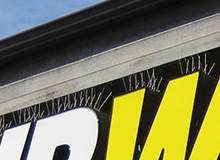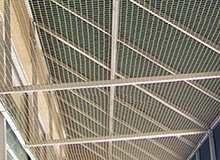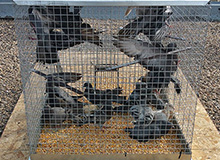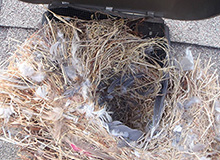Pro Bird Control Lexington, Kentucky
Call us now at 859-202-3555 for professional bird control services in Lexington, KY.

859-202-3555 - Call 24/7
We work 7 days a week - go ahead and call evenings and weekends!
Licensed & Insured
We carry liability insurance and all Kentucky licenses.
Professional Service
Treating both birds and customers with courtesy and respect.
Featured Bird Control Services
We are a professional bird control company servicing Lexington, KY. We solve problems with birds afflicting residential and commercial properties. We handle birds such as pigeons, sparrows, starlings, grackles, Canada Geese, and more. We most commonly receive calls about birds roosting on or even in buildings and ledges, leaving their feces behind. We not only remove birds, but we provide a wide array of services, from bird damage repairs, bird prevention services, bird dropping cleaning, and more. See our Lexington Bird Control Prices page to learn more about what we charge. We are fully licensed and insured in Kentucky, and we answer our phones 24/7. Call us now at 859-202-3555 for a free price quote and to schedule a same-day or next day appointment for bird control.
About Our Company

Services We Offer
- Bird Trapping
- Bird Prevention
- Droppings Cleanup
Best service in Lexington
- Superior bird control from roof to ground, start to finish.
- Available 24/7 with weekend and same-day appointments
- Humane treatment of birds and professional service for you.
Client Testimonials
-
Thank you for coming to my home on a Sunday to get the falcon in my garage - I almost had a heart attack before you showed up!
-
Pro Bird Control Lexington solved a problem with pigeons our building, after two other Kentucky companies failed - and at a price lower than the others! Thank you!
-
My regular pest control company couldn't handle my bird problem - these guys bird-proofed my warehouse in a week! I've been bird-free ever since!
FREE SERVICE: If you can't afford to hire our services, you can attempt some other alternatives:
Fayette County, KY - (859) 425-2255
Kentucky Dept of Wildlife - 502-564-3400
Furry Fixers Wildlife Rehab - 502-542-7371
Lexington police - (859) 258-3600
See our Lexington Bird Control Prices page to learn more about what we charge.
Pro Bird Control Lexington Tip of the Month:
Do you have some idea about Canada goose?
There are two different genus of the goose family
- the Branta genus and the Anser genus. Though a wild bird, the Canada goose is of the Branta genus. Even though there are seven different subspecies in this genus, this type of goose exhibits specific characteristic features that make it stand out from the rest. These are;
- Appearance
- Biology
- Life cycle
- Habitat
- Diet
- Behavior
This is a large goose with a black head and neck. It also sports a "chinstrap" that clearly distinguishes it from the rest of the species. Its gosling, however, has a yellow plumage around the neck which turns black upon maturity.
Biology
These birds can only mate after reaching their second birthday. And when they do, they mostly remain faithful to that one partner who always stays close by until death does them part. The female lays an average of five eggs and even though both parents guard the nest during incubation, she spends more time in the nest than the male partner.
The incubation period can be as short and as long as 24 and 32 days respectively. The Canada geese can adjust her egg-laying pattern to match the spring climates to increase the nesting success chances.
The adults lose their flight feathers for up to 40 days during their breeding season which occurs mostly during the annual summer molt. They, however, regain flight at the same time as when the goslings will be ready to make their maiden flights.
Life Cycle
The Canada geese lay their eggs between March and June and take up to 32 days to incubate the eggs. While nesting, the goose keeps turning the eggs over to allow even distribution of warmth to increase the chances of hatching. When they are between 40 and 70 days old, the goslings will start flying, wait to be fully mature at two years then also start mating but often times, won't start breeding until they are at least 3 years of age.
Habitat
The Canada goose prefers living around lakes, rivers, bays, and marshes.
Diet
They feed on different types of grass in open grasslands and fields. But in the marshes and mud, they use their strong beaks to burrow their heads and necks under the water and mud in search of food such as earthworms and others.
Behavior
Whenever the environmental conditions become too harsh for the Canada goose family, they will migrate to more favorable areas. They do this in V-shaped formations as a way of increasing their efficiency against the air resistance while airborne. They also fly while honking as a way of identifying and keeping together. There is safety in unity and numbers, according to this Canada goose. When in danger or under attack, the males defend their partners using wings while squirming for maximum effect.
See our Prices for bird control in Lexington, KY.





